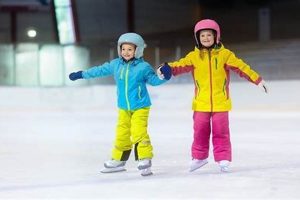Selecting appropriate recreational footwear for young skaters necessitates careful consideration. The ideal equipment provides adequate support, comfort, and safety features optimized for developing skills on the ice. These attributes contribute to a positive learning experience and minimize the risk of injury during initial skating endeavors. Models designed specifically for smaller feet often incorporate adjustable sizing to accommodate growth spurts.
The availability of well-designed equipment fosters interest in ice skating as a healthy and enjoyable activity. Proper fit and construction enhance performance, allowing children to develop coordination and confidence. Historically, advancements in materials and manufacturing techniques have led to safer and more comfortable options, making the sport more accessible to a wider range of young participants. This, in turn, promotes physical fitness and social interaction.
This analysis will delve into the key factors to consider when choosing equipment for young skaters, including blade quality, boot construction, and overall safety features. Further sections will evaluate different types of models currently available and offer guidance on proper sizing and maintenance to ensure optimal performance and longevity of the equipment.
Guidance for Selecting Suitable Ice Skates for Young Skaters
Choosing the appropriate ice skates for children is critical to their safety, comfort, and enjoyment of the sport. The following tips provide guidance on navigating the selection process.
Tip 1: Prioritize Proper Fit: Accurate sizing is paramount. Measure the child’s foot while they are wearing skating socks. Excess space inside the boot can lead to instability and blisters. Consult sizing charts provided by manufacturers, as these can vary.
Tip 2: Evaluate Ankle Support: Stiff ankle support is essential, especially for beginners. The boot should provide firm lateral stability to prevent ankle roll. Check for adequate padding around the ankle area for comfort and support.
Tip 3: Consider Blade Quality: Stainless steel blades offer superior edge retention compared to carbon steel. Sharper blades enhance gliding ability and control. Ensure the blades are securely attached to the boot and free from defects.
Tip 4: Assess Boot Construction: Durable, water-resistant materials are recommended. Look for boots constructed from leather or high-quality synthetic materials. Reinforced stitching and sturdy soles contribute to longevity.
Tip 5: Verify Safety Features: Check for features such as reinforced toe caps and heel counters to protect against impact. Ensure the laces are durable and easy to tighten. Avoid skates with excessive embellishments that could pose a safety hazard.
Tip 6: Explore Adjustable Models: For rapidly growing children, adjustable skates can offer extended use. These models typically feature mechanisms to expand the boot size incrementally, providing a cost-effective solution.
Tip 7: Factor in Skill Level: Beginner skaters require more supportive skates than those with experience. As skill progresses, skaters may benefit from models with increased flexibility and maneuverability.
Adhering to these guidelines facilitates the selection of safe, comfortable, and performance-enhancing ice skates for young participants. The benefits of choosing appropriate equipment include reduced risk of injury, improved skating skills, and increased enjoyment of the activity.
The subsequent sections will offer specific model recommendations and discuss maintenance procedures to ensure the continued performance and safety of the selected equipment.
1. Ankle Support
Ankle support is a foundational element in quality ice skates for children, directly affecting safety and skating proficiency. Inadequate ankle support increases the likelihood of instability and ankle injuries, particularly for beginners still developing their balance and motor skills. Stiff, well-constructed ankle support provides the necessary stability to maintain an upright posture and execute basic skating movements with control. A rigid boot structure minimizes lateral movement, preventing the ankle from rolling inwards or outwards, which is a common cause of sprains.
The effectiveness of ankle support is observable in real-world scenarios. Children using skates with insufficient support often exhibit wobbly strides, difficulty maintaining balance, and a tendency to fatigue quickly due to the increased effort required to compensate for the lack of stability. Conversely, skates with robust ankle support allow children to develop confidence and technique more rapidly, as they can focus on mastering skills rather than struggling to stay upright. For instance, properly fitted hockey skates with high ankle support enable young players to perform agile maneuvers and quick stops safely.
The significance of ankle support extends beyond injury prevention; it directly influences the learning curve and enjoyment of ice skating. Skates providing firm, comfortable support allow children to skate for longer periods with less fatigue, encouraging practice and skill development. Compromising on ankle support to save costs or opt for a more flexible boot ultimately hinders progress and increases the risk of injury. Therefore, selecting skates with adequate ankle support is paramount when prioritizing the safety and development of young skaters.
2. Blade Quality
Blade quality is a determining factor in the performance and safety of ice skates for children. The composition and construction of the blade influence gliding efficiency, edge control, and overall maneuverability on the ice. Low-quality blades, often made from softer metals, dull quickly and fail to maintain a sharp edge, resulting in reduced grip and increased effort to propel oneself. This negatively impacts the skating experience, making it difficult for children to learn and execute basic techniques. Conversely, high-quality blades, typically constructed from hardened steel or stainless steel, retain their sharpness longer, providing superior edge control and gliding performance.
The practical significance of blade quality becomes apparent when considering the demands of different skating styles. Recreational skating requires a blade that offers a balance of glide and stability, while figure skating necessitates blades with precise edges for performing jumps and spins. Hockey skates demand durable blades that can withstand the impact of pucks and the stress of aggressive movements. For example, a child using figure skates with low-quality blades may struggle to execute basic edges and turns, hindering their progress and potentially leading to frustration. Similarly, a young hockey player with dull blades will experience reduced speed and agility, putting them at a disadvantage on the ice. Therefore, the selection of appropriate blade material and sharpness is important for the intended use.
In conclusion, blade quality is a non-negotiable aspect when choosing children’s ice skates. Investing in skates with high-quality blades ensures optimal performance, enhances safety, and contributes to a more enjoyable and rewarding skating experience. While factors such as fit and ankle support are also essential, the blade’s ability to maintain a sharp edge and provide reliable control directly translates to improved skill development and reduced risk of accidents. Prioritizing blade quality ultimately supports the long-term success and safety of young skaters.
3. Proper Fit
Proper fit is a crucial determinant of the “best childrens ice skates,” serving as a foundational element for safety, comfort, and performance. Ill-fitting skates can lead to a cascade of negative consequences, ranging from blisters and discomfort to impaired balance and an increased risk of injury. The cause-and-effect relationship is straightforward: inadequate fit results in compromised control, hindering skill development and potentially leading to falls. For example, skates that are too large provide insufficient ankle support, forcing the child to compensate with unnatural movements, increasing fatigue, and potentially causing ankle strain. Conversely, skates that are too small constrict the foot, causing pain, restricting circulation, and potentially leading to long-term foot problems.
The importance of proper fit extends beyond immediate comfort. It directly impacts the child’s ability to learn and progress in ice skating. Correctly fitted skates allow for efficient energy transfer, enabling the child to execute maneuvers with greater precision and less effort. This, in turn, fosters confidence and encourages continued participation. A real-world example illustrates this: A child fitted with properly sized skates is more likely to maintain balance during turns and stops, allowing them to focus on refining their technique rather than struggling to stay upright. The practical significance of understanding proper fit lies in its ability to maximize the benefits of skating, turning it into a positive and enjoyable experience.
In summary, proper fit is not merely a desirable attribute but an essential component of high-quality ice skates for children. Overlooking this aspect can negate the advantages of other features, such as blade quality and ankle support. Challenges in achieving proper fit often stem from the rapid growth of children’s feet and the variability in sizing standards across manufacturers. Overcoming these challenges requires careful measurement, consideration of individual foot shape, and adherence to manufacturer sizing guides. By prioritizing proper fit, parents and guardians can ensure that children have the best possible experience on the ice, fostering a lifelong love for skating while minimizing the risk of injury.
4. Safety Features
Safety features constitute an integral component in the design and selection of recreational ice skates for children. Their presence directly mitigates the risk of injury and contributes significantly to a positive skating experience. The following outlines several key safety aspects that are incorporated into superior models.
- Reinforced Toe Caps
Reinforced toe caps provide crucial protection against impact and compression injuries. These protective elements safeguard the delicate bones in the toes from accidental collisions with the ice surface, other skaters, or hockey pucks. An example would be a skater inadvertently kicking the boards at an ice rink. A robust toe cap can prevent fractures and contusions, promoting confidence and minimizing fear of injury. The best models integrate this feature seamlessly into the boot’s construction without compromising comfort or flexibility.
- Durable Ankle Support Systems
Beyond basic ankle support, superior children’s ice skates incorporate advanced ankle support systems designed to prevent excessive lateral movement and ankle sprains. These systems often involve a combination of rigid external supports and internal padding. Consider a scenario where a young skater loses balance; a well-designed ankle support system will help stabilize the ankle joint, reducing the likelihood of a sprain. The most effective systems are adjustable to accommodate individual ankle anatomy and skating style.
- Secure Closure Mechanisms
Secure closure mechanisms are essential for maintaining a snug and stable fit, which directly impacts safety and control. Laces, buckles, and hook-and-loop straps must function effectively to prevent the skate from loosening during use. Improperly secured skates can lead to instability, increasing the risk of falls and injuries. Imagine a child’s skate laces coming undone mid-skate; the resulting instability could easily lead to a fall. High-quality closure mechanisms are durable, easy to operate, and designed to withstand the rigors of frequent use.
- Reflective Elements
Reflective elements enhance visibility, particularly during low-light conditions or outdoor skating. These elements increase the likelihood that other skaters and pedestrians will notice the child, reducing the risk of collisions. For example, skaters on outdoor rinks during dusk benefit significantly from reflective materials incorporated into their equipment. Strategically placed reflective strips or patches on the skates enhance overall safety and visibility.
These safety features collectively contribute to the overall performance and suitability of ice skates for children. The selection of models incorporating these elements demonstrates a commitment to prioritizing safety and promoting a positive skating experience. The absence of these features can significantly increase the risk of injury and detract from the enjoyment of the sport.
5. Boot Material
The material used in the construction of an ice skate boot is a critical factor influencing performance, comfort, durability, and safety, thus establishing a direct link to defining superior skates for children. The choice of boot material impacts support, flexibility, insulation, and resistance to wear and tear, all of which are crucial considerations for young skaters. Low-quality materials may result in inadequate ankle support, accelerated wear, and reduced thermal protection, leading to discomfort and an increased risk of injury. For instance, a skate boot constructed from thin, non-water-resistant synthetic material will offer minimal support, quickly degrade with use, and fail to keep the child’s feet warm and dry, particularly during extended skating sessions or in colder environments. A superior boot material, conversely, provides a secure and comfortable fit, resists abrasion, and effectively insulates against the cold, thus promoting a safer and more enjoyable skating experience.
Furthermore, specific boot materials offer distinct advantages tailored to varying skill levels and skating styles. Leather boots, while requiring more maintenance, provide excellent moldability and support, conforming to the skater’s foot over time. Synthetic materials, often found in more affordable skates, offer water resistance and durability. Hybrid constructions combine the benefits of both, providing a balance of support, comfort, and resistance to the elements. For example, hockey skates often utilize reinforced synthetic materials to withstand the impact of pucks and collisions, while figure skates may incorporate leather or advanced composites to provide the precise support required for jumps and spins. Understanding the properties of different boot materials allows for informed decision-making based on the intended use and the skater’s specific needs.
In conclusion, the selection of appropriate boot material is paramount in determining the quality and suitability of ice skates for children. Factors such as support, durability, insulation, and resistance to wear must be considered to ensure optimal performance, comfort, and safety. While other features like blade quality and fit are also essential, the boot material forms the foundation upon which these other elements rely. Prioritizing high-quality boot materials contributes significantly to a positive skating experience and promotes the long-term development of young skaters. Challenges in material selection often arise from balancing cost considerations with performance requirements; however, investing in superior boot materials generally translates to enhanced durability, safety, and overall satisfaction.
6. Adjustability
Adjustability, as a feature in children’s ice skates, holds significant value due to the rapid growth rate experienced by children. This characteristic is a primary consideration when determining what constitutes superior quality in this category of sporting equipment. Skates with adjustable sizing mechanisms can accommodate multiple foot sizes, extending the usable lifespan of the product. The lack of adjustability necessitates more frequent replacements as the child’s foot grows, increasing the overall cost of participation in the sport. Failure to adapt to a growing foot creates discomfort and potentially contributes to impaired skating technique, affecting the child’s performance on the ice. An example of the benefits of adjustability would be a skate that expands up to three sizes, saving the parent from purchasing new skates every year as the child grows.
The presence of an effective adjustment mechanism also contributes to safety. Skates that are either too large or too small present a hazard. A skate that is too large lacks proper ankle support and stability, increasing the risk of falls. A skate that is too small restricts circulation and can lead to discomfort and blisters, potentially causing the child to avoid skating altogether. Adjustable skates, when properly fitted, provide a secure and comfortable fit throughout the growth period, promoting both safety and enjoyment. The practical significance of adjustability is underscored by the fact that it addresses a fundamental need in children’s products adaptability to physical change.
In conclusion, adjustability is a key attribute that defines a superior product in the context of children’s ice skates. This feature provides economic benefits by extending the lifespan of the skates and offers enhanced safety and comfort by ensuring a proper fit as the child’s foot grows. The challenges associated with adjustability involve maintaining durability and performance across the range of sizes offered by the adjustment mechanism. Overcoming these challenges through robust design and high-quality materials ensures that adjustable skates remain a viable and advantageous option for young skaters.
7. Durability
Durability constitutes a primary determinant in evaluating ice skates for children, directly influencing the long-term value and safety of the equipment. The inherent connection arises from the demanding conditions of ice skating, which expose skates to repeated impacts, abrasions, and exposure to moisture. The selection of materials and construction techniques directly impacts the skate’s capacity to withstand these stressors. Substandard skates exhibit premature wear, compromising structural integrity and increasing the risk of component failure, which in turn creates hazardous skating conditions. Conversely, durable skates maintain their functionality and protective qualities over extended periods, providing consistent performance and minimizing the need for frequent replacements. An example would be skates constructed with reinforced stitching and high-impact resistant materials, which are less prone to seam separation and cracking under stress.
The practical significance of durability extends beyond economic considerations. Durable skates offer enhanced protection against injuries. Robust outer shells shield the foot from impacts, while high-quality blade attachments prevent blade detachment, a potentially dangerous occurrence. The ability of the skates to withstand rigorous use translates directly into increased safety, particularly for novice skaters who are more susceptible to falls and collisions. Furthermore, durable skates contribute to a more positive skating experience, as they provide consistent support and performance, fostering confidence and enabling children to focus on skill development rather than equipment concerns. This is particularly evident in the arena of hockey, where skates must endure the constant pounding of stop-and-go motion in addition to impacts from pucks or collisions with other players.
In summation, durability is not merely a desirable attribute but a critical characteristic of superior ice skates for children. Overlooking durability in favor of cost savings often results in a false economy, as substandard skates require more frequent replacement and pose increased safety risks. Prioritizing durability through the selection of high-quality materials and construction techniques ensures that the skates provide reliable performance, enhanced safety, and long-term value. The challenge lies in balancing durability with comfort and affordability; however, the investment in durable skates ultimately contributes to a more enjoyable and safer skating experience, fostering a lifelong appreciation for the sport.
Frequently Asked Questions Regarding Ice Skates for Young Children
The subsequent questions address common inquiries and misconceptions concerning the selection and utilization of recreational ice skates for young participants. This section aims to provide clarity and guidance based on established industry standards and safety recommendations.
Question 1: At what age is it appropriate to introduce a child to ice skating?
The appropriate age for introducing ice skating varies based on individual motor skill development and coordination. Most children exhibit sufficient balance and coordination to begin learning between the ages of 3 and 5. Early introduction, under parental supervision, can foster a positive association with physical activity.
Question 2: How should a child’s foot be measured for ice skate sizing?
Foot measurement should be performed while the child is wearing skating socks. Employ a Brannock device or a ruler to measure the length and width of the foot in millimeters. Consult the manufacturer’s sizing chart, as sizing standards can vary significantly between brands. Prioritize length measurement for optimal fit.
Question 3: What constitutes adequate ankle support in children’s ice skates?
Adequate ankle support is characterized by a rigid boot structure that minimizes lateral movement and prevents ankle roll. The boot should provide firm stability without restricting forward flexion. Look for reinforced ankle padding and secure lacing systems to ensure optimal support.
Question 4: What type of blade material is recommended for children’s ice skates?
Stainless steel blades are generally recommended due to their superior edge retention and resistance to corrosion compared to carbon steel. Sharper blades enhance gliding efficiency and control, facilitating skill development. Ensure the blades are properly sharpened and maintained.
Question 5: How often should children’s ice skates be sharpened?
The frequency of sharpening depends on usage and ice conditions. Regular skaters may require sharpening every 20-40 hours of ice time. Signs of dull blades include difficulty maintaining edges, reduced glide, and increased effort to propel oneself. Professional skate sharpening services are recommended.
Question 6: What safety precautions should be taken when children are ice skating?
Mandatory safety precautions include wearing a properly fitted helmet certified for ice skating or hockey. Wrist guards and knee pads are recommended for beginners to protect against impact injuries. Ensure the skating surface is free from hazards and is properly maintained. Adult supervision is essential, particularly for young children.
This section has addressed key considerations in selecting and utilizing ice skates for children. Adherence to these guidelines can promote safety and enhance the overall skating experience.
The subsequent section will delve into specific product recommendations and provide detailed maintenance instructions for children’s ice skates.
Concluding Remarks on Ice Skates for Young Skaters
This analysis has underscored the multifaceted considerations crucial to selecting appropriate ice skates for children. Factors spanning ankle support, blade quality, fit, safety features, boot material, adjustability, and overall durability have been examined. The synthesis of these elements dictates the suitability and efficacy of equipment intended for young participants. Prioritizing these aspects mitigates risks and maximizes the potential for skill development, ultimately fostering a positive and enduring engagement with the sport.
The selection process requires meticulous evaluation, balancing performance criteria with safety considerations. Responsible parties should leverage the insights detailed herein to facilitate informed purchasing decisions. Continued advancements in materials and design are anticipated to further enhance the safety and performance characteristics of ice skates, ensuring that future generations of young skaters benefit from increasingly refined and protective equipment. Diligence in this area promotes both individual well-being and the sustained growth of the sport.







